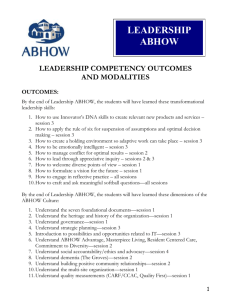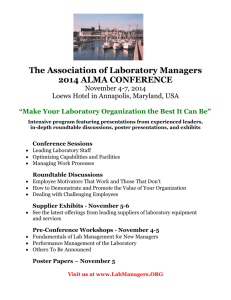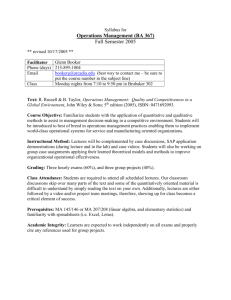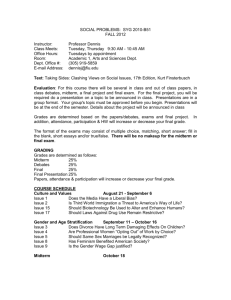Faculty and Staff Home Pages
advertisement
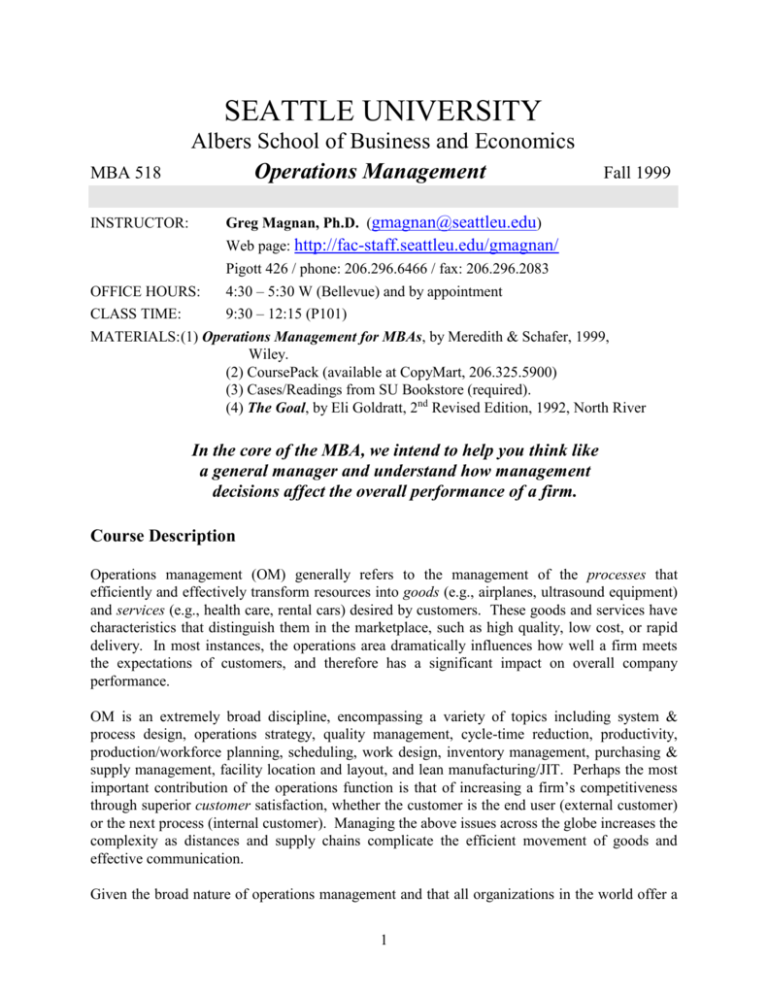
SEATTLE UNIVERSITY MBA 518 Albers School of Business and Economics Operations Management Fall 1999 Greg Magnan, Ph.D. (gmagnan@seattleu.edu) Web page: http://fac-staff.seattleu.edu/gmagnan/ INSTRUCTOR: OFFICE HOURS: Pigott 426 / phone: 206.296.6466 / fax: 206.296.2083 4:30 – 5:30 W (Bellevue) and by appointment CLASS TIME: 9:30 – 12:15 (P101) MATERIALS: (1) Operations Management for MBAs, by Meredith & Schafer, 1999, Wiley. (2) CoursePack (available at CopyMart, 206.325.5900) (3) Cases/Readings from SU Bookstore (required). (4) The Goal, by Eli Goldratt, 2nd Revised Edition, 1992, North River In the core of the MBA, we intend to help you think like a general manager and understand how management decisions affect the overall performance of a firm. Course Description Operations management (OM) generally refers to the management of the processes that efficiently and effectively transform resources into goods (e.g., airplanes, ultrasound equipment) and services (e.g., health care, rental cars) desired by customers. These goods and services have characteristics that distinguish them in the marketplace, such as high quality, low cost, or rapid delivery. In most instances, the operations area dramatically influences how well a firm meets the expectations of customers, and therefore has a significant impact on overall company performance. OM is an extremely broad discipline, encompassing a variety of topics including system & process design, operations strategy, quality management, cycle-time reduction, productivity, production/workforce planning, scheduling, work design, inventory management, purchasing & supply management, facility location and layout, and lean manufacturing/JIT. Perhaps the most important contribution of the operations function is that of increasing a firm’s competitiveness through superior customer satisfaction, whether the customer is the end user (external customer) or the next process (internal customer). Managing the above issues across the globe increases the complexity as distances and supply chains complicate the efficient movement of goods and effective communication. Given the broad nature of operations management and that all organizations in the world offer a 1 product or service (and therefore have “operations”), there are many opportunities to highlight the manner in which operations management interfaces with other company disciplines. During this course, we will see examples of integration between operations the other courses in the MBA core—finance (e.g., evaluating operations investment decisions), marketing/sales (e.g., providing customers what they want when they want it), and management (e.g., how people and processes are managed.) In addition, we will explore ways in which the functions of accounting (e.g., measuring “efficiency” and inventory), engineering (e.g., how products interact with processes and the environment) can impact the operations system. MBA 518 is designed to help students understand how the operations function—in both manufacturing and service industries—works with other functions to provide superior products and services to its customers. Successful companies demonstrate that world-class performance is achieved through crossfunctional approaches. A recurring theme throughout this course will be the interaction between the operations function and the engineering, finance, accounting, management, information systems, and marketing functions as business problems arise and solutions are identified. Through cases, this course will highlight the relationships between the operations and other functions by analyzing their interactions within the global business environment. Each case has an international setting and provides an opportunity to analyze critically how decisions in one function in one country can affect the other functions and, ultimately, the success of the firm. Finally, we will discuss many of the issues associated with managing the people in an operations group (where most of the employees are located.) Another objective is to introduce students to the tools and techniques of OM, many of which apply to all functions of a business (as well as the processes within those functions.) As firms seek to identify and improve core processes, the operations tools associated with improvements in quality, time/speed, and productivity can (and should) be applied to all facets of an organization. Staffing levels, capacity, facility layout and location, process flow analysis, quality improvement, and cycle time reduction are examples of topics in which the analytical tools can be applied to other functional areas. Competencies Given structural changes in competition, one of the most important skills for managers and workers is the ability to communicate. This course will give students additional communications exposure through presentations, working with colleagues, and working on writing skills. In achieving these objectives, several other competencies will be addressed, including: Critical and analytical reasoning: Cases and outside readings will emphasize the interrelatedness of functions, requiring students to determine and consider the effects of actions in one department on results in another and on the firm overall. Customer focus: Since operations involves the management of processes, and customers usually appear at the end of processes, an understanding of customer requirements is critical to effective management. Effective writing and presentation skills: Case write-ups and papers will challenge students to write concisely, while the final project involves an oral presentation requiring the use of 2 presentation software. Values/Ethics/Environmental awareness: Given that the majority of a firm’s assets reside in operations, the deployment of these assets effects many dimensions. Understanding the relationship between the operations function and the environment in which it operates is critical. Invariably people work in the function and their interaction with operations system must be considered in the design and operations of that system. Interpersonal skills: Through group projects outside of class and in-class discussion, students will have many opportunities to practice their listening skills. One of the great benefits of an evening program is the diverse background of the students and interpersonal skills will serve to better understand the views of different students. Integration of business functions: This course is constructed around integrating business functions. Every concept presented will involve discussion of its impact on the firm and other functions. Cases and articles will be used to highlight interdependencies. Quantitative skills: Several operations concepts involve numerical evaluation (e.g., capacity planning, statistical process control, location decisions). These topics appear in cases and the analyses may require utilizing quantitative skills to provide input for the critical and analytical reasoning mentioned above. Teaching Method This class will incorporate a collection of lectures, cases, text readings, in-class simulations, and articles from academic and business periodicals to promote operations and cross-functional learning. I believe that use of these different tools will satisfy a wider variety of learning styles and to keep long class sessions interesting. In-class discussions are a major component of learning in this course. Course Requirements First, I would like to mention the quality of this course is largely a function of the involvement of you, the student/customer (as is the case in most service encounters!) To that end, the bulk of responsibility for learning is yours—keeping current with the reading and participating in case and class discussions are critical to a successful course. 1. PLANT TOUR PRESENTATION / WRITE-UP: The purpose of the tour is to merge theory with reality by exposing students to the operations of actual firms. Students will be placed into teams of 3-4 (or students will construct their own teams) and each team will arrange a tour of the operations function of a local manufacturing or service company that is involved in international trade. Each team will analyze the practices and policies the firm employs within the operations function. These practices can include the plant layout, the use of quality tools, materials flow, planning, the role of inventory in the supply chain, people, etc. Addressing how the firm handles these issues in light of their business environment is required. Teams can approach this requirement in two ways. The first is to analyze a firm’s operations from a broad, systems perspective. The focus in this analysis is to identify how the individual 3 elements of operations work together to provide support to the international business strategy. The second approach is to focus on a limited set of elements/processes (one or two) such as how inventory is managed, how orders are conveyed from sales to the planning system to the floor, or perhaps how a centralized planning system orders materials for plants in different countries. Teams can deliver their projects in one of two ways—either through an in-class presentation or a 20 (maximum!) page paper. Team choosing to present their findings will do so during the final two class sessions. Presentations will be limited to 20 minutes in length (NOTE: due the extreme importance of managing time during these sessions, a five-point per minute penalty will be assessed to presentations longer than 20 minutes.) Presentations will be graded on content, organization, clarity, creativity, and level of interest. Teams must use a professional presentation software package and are encouraged to use one compatible with the ASBE offerings so the multimedia cart can be used (Microsoft Powerpoint.) Please review the project evaluation sheet appearing (forthcoming) for specific areas to be evaluated. Teams presenting must submit a copy of the slides used in the presentation before the presentation begins. Teams choosing to write their findings/analysis must submit their reports on or before the finals week class meeting (see schedule). Papers should be no longer than 20 double-spaced pages (charts and diagrams may be included as an appendix). Presentations and papers should focus on observations of how the company applies the concepts discussed in class to support their business strategy.. Each team must select their own firm to visit. Please notify the instructor of your team’s choice by the end of October so that duplicates can be avoided. Please keep in mind that, in addition to the larger local companies, there are numerous smaller firms that can be visited. However, companies with less than 20 employees should be avoided. Finally, please recognize that your role is not to prepare a marketing presentation of the merits of the firm you visit. Instead, your role is one of an analyst of the operations organization. Determining recommendations based on the analysis is encouraged 2. EXAMS: A midterm and a final exam will be given. The exams will be “take-home” and will consist of about 5 multiple choice questions (both conceptual and analytical) and about 8 short essay questions. The exams are due 2 weeks after they are handed out. The midterm will be due October 30, 1999 and the final is due December 11, 1999. Make-up exams are not given. 3. PARTICIPATION: On time attendance and participation in class discussions are mandatory. Strive to be prepared and concise (i.e., get to-the-point and avoid rambling in your remarks.) Quantity of quality contributions to case discussions in class will count 15% of your grade and will be evaluated by a combination of the instructors’ judgment and the rankings of your peers at the end of the quarter. At the end of the quarter, you will be asked to “identify the 5-7 students from which you learned the most in class discussions.” These will be tallied and serve as the basis for determining your attendance and participation score. It should be mentioned that participation does not translate 4 into volume! Please be courteous of others at all times and be cognizant of the limited bandwidth. 4. CASES: You are required to turn in a total of two written case analyses. Each is to be double-spaced, no longer than four pages, word processed (no 10-point fonts, please), and should attach (at the back) a copy of the scoring sheet appearing at the end of the syllabus. Cases are due the day the case is to be discussed. At least one of the cases must be done individually. Group efforts: hand in one case and all contributors will receive the same score for that case. For the remaining cases, participation in discussions is still required. If necessary, this requirement will be upgraded to asking each student to submit a 1-page summary of all cases (in addition to the two required. Required Format: Please analyze and write-up cases using the structure outlined below. Respond as if you are an outside consultant to the case principals. As such, place more emphasis on problem identification and solution implementation/action plans than on an overview of issues. Section headings are a must in your analyses (use those in bold below.) 1. Executive Summary: One paragraph summary of key issues and recommendations. This should be a one or two (maximum) paragraph summary that can “stand apart” from the rest of the analysis. 2. Organizational Profile/Overview: Brief discussion of material relevant to the analysis, such as product/services offered, competitive priorities, industry trends, etc. 3. Critical Issue(s): Identification of the major problems and issues present in the case. 4. Alternatives: Identify the feasible solutions or alternatives available to the principals. Include some evaluation or discussion of strengths and weaknesses of each alternative (bullet format is just fine.) 5. Recommendation: Selection of preferred actions with justification. Be sure to address potential negative consequences. 6. Action Items: Short list of prioritized action items for principals. If appropriate, break list into short- and long-term. • • • Note: In some cases, you may prefer to group issue/alternative/recommendation rather than repeating items. This, too, is just fine. Cases are due the day we will discuss them. Late papers will not be accepted. While written work must be completed individually, you are encouraged to discuss issues in the case with your colleagues. Plagiarism: When you put your name on the written case analysis, you are stating that the writing is your own and not from another student, author, etc. Plagiarism is a serious academic offense at the Albers School and is grounds for dismissal from the program. For persons whose skills in written English are anything less than superb, a copy of Elements of Style by Strunk and White will be useful. “How” (i.e., writing style) you say something is 5 equally as important as “what” (i.e., content) you have to offer. If you are an international student who has difficulty with English grammar, you are urged to contact the SU Writing Center (296-6239) and make an appointment well in advance of the due date of the paper. 5. “THE GOAL” REPORT: Each student will submit a short analysis of The Goal. The analysis should center on your opinion of what “the goal” is (1 to 2 pages) and, more important, how the concepts might be applied in your firm, division, department, or group. You are encouraged to identify how Goldratt's measures (T, OE, and I) would apply to the scenario you select. The write-up should be no longer than three double-spaced pages and is due November 13, 1999. Grading A straight grading scale will be used to determine final grades (A = 95-100, A- = 90-94, B+ = 8789, B = 83-86, B- = 80-82, C+ = 79-77, etc.) Course requirements are assigned the following weights: Plant Tour Pres. or Paper: Case Write-ups (2): Final exam: 25% 15% 15% Participation: Midterm exam: “The Goal” Report 13% 20% 12% Feedback Team A 2-person feedback team will be created on the first evening whose function is to serve as a liaison between the class and the instructor. The team will communicate class perception on issues such as the learning instruments applied, class pace, session clarity, workload, etc. to the instructor. The team will meet with the class to gather feedback and suggestions/solutions to perceived problems and then reports back to the instructor with the data collected. The team is voluntary and will meet once or twice during the quarter. Please note that the formation of this committee does not mean that individual office appointments should not be made. On the contrary, I still encourage you to seek assistance or provide input. 6 TENTATIVE COURSE SCHEDULE Cls. Date # Topics Elements Ch Articles [auth. (yr)] Case or Activity Module 1: Strategic Global Operations 1 9-25 Syllabus • Review Introduction to • Competitiveness Operations • Services Management 2 Operations Strategy 10-2 World Class Product & Process Planning • Comp. Priorities • OS Elements • Product Design for Global Dist. • Social Responsib. • Process Types • World Class Mfg. 1, None 2 4 [skim] 5 Dell & Magretta (98)* McGuire (99) Bodenstab (99) Simison (99) American Connector Soopers Video Module 2: Producing Quality Goods & Services 3 4 10-9 Quality Management • • • • 10- Global Issues 16 in Service Operations • Mfg. Differences • Blueprints • Service Quality TQM/People 7-Tools of quality Workplace Safety Environmental 3 Adler (93) Lin & Hidalgo (99) Chase & Stewart (94) -- Petzinger (98) Keltner, et al. (99) Collier (99) AT&T Universal Card Services Shouldice Hospital Limited Module 3: Operations & Finance/Accounting Interface 5 6 • Functions of Inv., Forms, and COSTS • Independent Dem. Global Supply • Continuous Chain Mgt. Systems • Periodic Systems • Service Levels 10- Inventory 23 Management 10- Global Supply • Analysis 30 Chain Mgt. • Strategic Influences • Purchasing Location & • Logistics Capacity • Take-home Midterm due 7 8 (242262) 9 (283301) 6 (162183) [skim] Holmstrom (97) Mitro (98) Levy (97) Quick (99) Walker (98) Fung & Magretta (98)* Fisher, et al. (94)* Ferdows (97)* [skim] Polaroid Corp.: European Distribution System Sport Obermeyer Module 4: Operations & Marketing Interface 7 8 9 10 11 11-6 Lean Production Systems • Strategic Elements • Decision Factors 11- Planning 13 Issues • • • • 11- Project Day 20 12-4 Presentations 12- Presentations 11 Aggregate Planning Dependent Demand Enterprise Systems “The Goal” report due 9 (301320) 8 (262279) Womack & Jones (96) Spear & Bowen (99) Brander (98) Olinger (98) Kirkpatrick (98) Minahan (98) Upton-Plant Tour (97)* • Presentations • Take-home Final due * indicates articles were part of casepack purchased at SU Bookstore 8 JIT Demonstration (not a case!) Nypro CASE WRITE-UP EVALUATION FORM Operations Management, Fall 1999 Directions: Please copy this form and staple it to the front of your submitted case. _____________________________ Case Name ___________________________ Student Name TECHNICAL MERIT/ CONTENT ( 65 %) - Statement of business problem or challenge - Evaluation of Proposed Actions (are they useful, well thought-out, and practical?) - Balanced Presentation (pros and cons are adequately represented, awareness of downside risks displayed) - Persuasiveness of supporting arguments - Creativity of ideas, suggested courses of action 62-65 = “Superior,” stands out from rest 59-61 = “Very Good,” above grad. average 52-58 = “Good”, expected grad-level work 51 or below = “Needs Work” ARTISTIC IMPRESSION/ STYLE ( 35 %) - Organization (ideas flow logically and smoothly) - Clarity and conciseness of writing style - Use of subheadings, where appropriate, for organizational clarity - Grammar & Spelling - Use of examples, where appropriate, to clarify ideas - Interest Level 34-35 = “Superior,” stands out from rest 31-33 = “Very Good,” above grad. average 28-30 = “Good,” expected grad-level work 27 or below = Needs Work Case Total Score = __________________ --------------------------------------------------------------------------------------------------------------------Additional comments: 9
